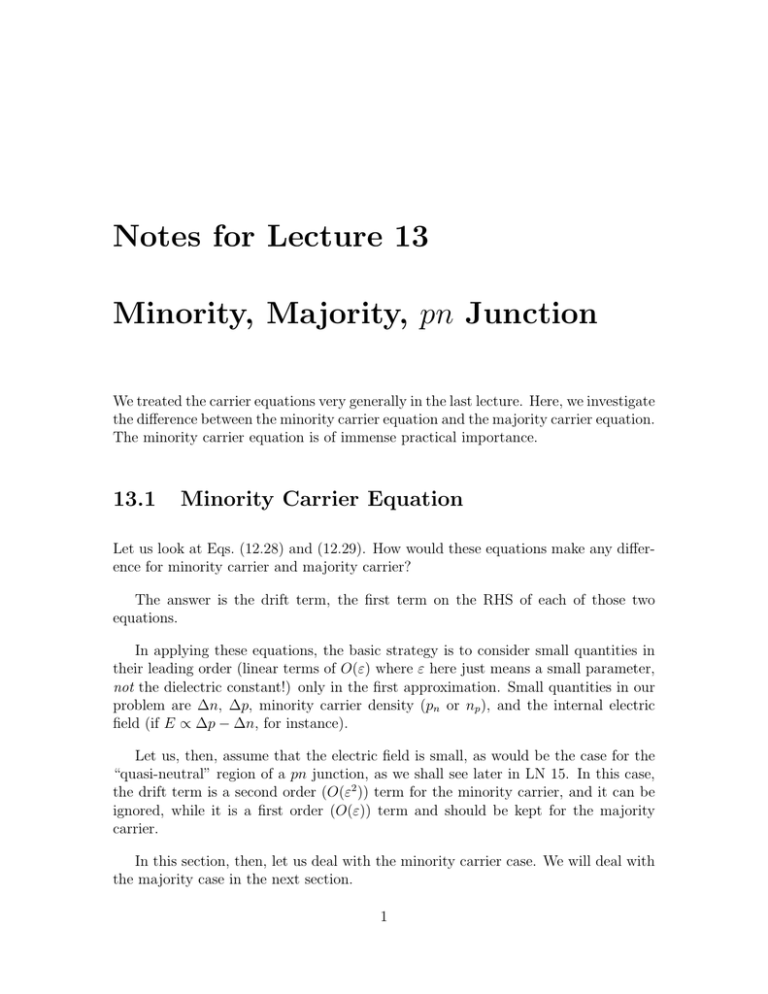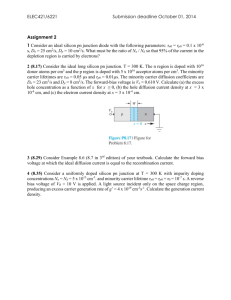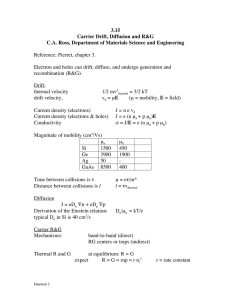Notes for Lecture 13 Minority, Majority, pn Junction - G.
advertisement

Notes for Lecture 13 Minority, Majority, pn Junction We treated the carrier equations very generally in the last lecture. Here, we investigate the difference between the minority carrier equation and the majority carrier equation. The minority carrier equation is of immense practical importance. 13.1 Minority Carrier Equation Let us look at Eqs. (12.28) and (12.29). How would these equations make any difference for minority carrier and majority carrier? The answer is the drift term, the first term on the RHS of each of those two equations. In applying these equations, the basic strategy is to consider small quantities in their leading order (linear terms of O(ε) where ε here just means a small parameter, not the dielectric constant!) only in the first approximation. Small quantities in our problem are ∆n, ∆p, minority carrier density (pn or np ), and the internal electric field (if E ∝ ∆p − ∆n, for instance). Let us, then, assume that the electric field is small, as would be the case for the “quasi-neutral” region of a pn junction, as we shall see later in LN 15. In this case, the drift term is a second order (O(ε2 )) term for the minority carrier, and it can be ignored, while it is a first order (O(ε)) term and should be kept for the majority carrier. In this section, then, let us deal with the minority carrier case. We will deal with the majority case in the next section. 1 13.1. MINORITY CARRIER EQUATION ∂∆np ∂ 2 ∆np ∆np = Dn − ∂t ∂x2 τn 2 ∂∆pn ∂ ∆pn ∆pn = Dp − ∂t ∂x2 τp (13.1) (13.2) It makes sense that without the drift term (which involves the coupling of an electric field to charge) these two equations have exactly the same structure. The meaning of the minority equations can be examined using the following two examples. 13.1.1 Minority Carrier Injection I Suppose that light is turned on suddenly at t = 0, and shines on a thin piece of a n-type Si crystal. The light generates electron-hole pairs at a constant rate GL . Assume that the light is flooding the crystal uniformly, and thus there is no spatial dependence in carrier densities. Let us solve for the time dependence of the minority carrier density pn . First of all, some words about the physics of the electron-hole generation by light illumination. As a function of photon energy, the absorption crossection would be very small, when the photon energy is well below the energy gap. For photons with energy well below the energy gap, the semiconductor is essentially transparent to the light. However, as the photon energy approaches the energy gap and go beyond it, there will be a large turn-on of the absorption crossection. This is the so-caled “absorption edge.” In this respect, let us look at Fig. T3.20. In that figure, the absorption coefficient α is plotted as a function of the wavelength of the photon. The absorption coefficient is defined as x≥0 I(x) = I0 exp(−αx) (13.3) where the light is incident on a specimen which occupies the region x ≥ 0 and I(x) is the intensity of light as a function of position inside the specimen, I0 being the intensity of light that is incident on the specimen. 1/α is the attenuation length or the skin depth of the photon: it measures how deep a photon can penetrate into the specimen. Looking at Fig. T3.20, notice that 1/α is as large as 1 cm at λ = 1.2 µm, while it becomes as short as 0.1 µm at λ = 0.5 µm. Why is this? This is due to the absorption edge being in between these two wave lengths. Recall that the energy G.-H. (Sam) Gweon 2 Phys. 156, UCSC, S2011 NOTES FOR LECTURE 13. MINORITY, MAJORITY, P N JUNCTION versus the wavelength of a photon is given by ~ω (eV) = 12398 1.2398 = λ (µm) λ (Å) (13.4) Thus, for the energy gap of Si, ≈ 1.1 eV, we get λ = 1.1 µm, which explains why the attenuation length becomes so small when λ becomes less than that value. Since the electron-hole carrier generation is due to the absorption of the photon, we will then have GL (x) = GL (0) exp(−αx) x≥0 (13.5) Coming back to the current example, then, we will assume that the wavelength is slightly lower than that for the energy gap, and the sample dimension is small, so that the light penetrates throughout the crystal. That is, we assume that the sample exists in the region 0 ≤ x ≤ d and that d 1/α, and so we can approximate exp(−αx) ≈ 1 for any 0 ≤ x ≤ d. So, we will simple drop the x dependence in GL . The mathematics of this problem is rather simple, with this setup. Without the spatial dependence, the minority carrier equation becomes ∆pn ∂∆pn + GL =− ∂t τp (13.6) Note that GL here is an example of Gnet as described at the end of the previous lecture note. This differential equation is an example of a so-called inhomogeneous differential equation, because there is a term GL , which is not dependent on ∆pn , which is our unknown. The general solution for an inhomogeneous differential equation is the sum of the general solution for the homogeneous version of that differential equation plus any “particular solution.” A particular solution is a solution that satisfies the full inhomogeneous equation. For instance, ∆pn = GL τp is a particular solution. Since any particular solution will do, this simplest particular solution is what we will take. Now, let us find the general solution for the homogeneous equation ∂∆pn ∆pn =− ∂t τp (13.7) While a direct integration by separation of variable is a good way to go for this, I like to keep in mind the following principle. 1. A differential equation is called an n-th order equation, where n refers to the highest order derivative involved. The above example is the first order equation in t, since a first derivative in t is all there is. G.-H. (Sam) Gweon 3 Phys. 156, UCSC, S2011 13.1. MINORITY CARRIER EQUATION 2. The general solution for an n-th order differential equation must involve n integration constants. Integration constants are constants that appear as the result of solving (“integrating”) the differential equation. They are not related to any quantities in the equation itself, but they are related to the physical conditions such as initial conditions or conserved quantities. 3. Conversely, if a solution with n arbitrary constants are found for a homogeneous differential equation, then that solution is the general solution of that homogeneous differential equation. The third point here gives us a means to find the general solution like the above equation from experience but with confidence. Clearly a solution for the above equation is ∆pn = exp(−t/τp ), where we simply used the fact that an exponential function is a self-replicating function as far as the differential calculus is concerned. Then, we can easily see that for any arbitrary constant A, ∆pn = A exp(−t/τp ) also is a solution to the above equation. Since the first order differential equation has one and only one integration constant, this is the general solution, as it has one integration constant A. Collecting all the information, then, the general solution for the original inhomogeneous equation is ∆pn = A exp(−t/τp ) + GL τp (13.8) How do we determine A? We need to look at the initial condition or the conserved quantities. The initial condition for this problem is that at t ≤ 0, there must not be any ∆pn , since the light was turned on at t = 0. Thus, ∆pn (t = 0) = 0 = A + GL τp . Thus, A = −GL τp . ∆pn = GL τp [1 − exp(−t/τp )] (13.9) The graph is shown in Figure T3.25. The excess hole density is turned on on a time scale of τp and it reaches the steady state value GL τp for t τp . The mathematical behavior shown above is the same as the charging behavior of a capacitor in an RC circuit. 13.1.2 Minority Carrier Injection II Different from the problem that we just described, now we consider a thick sample and photons with energy slightly higher than the energy gap. This means that the attenuation length of the photon is very short compared to the sample dimension. We also assume that it is very short compared to the diffusion length scale of the G.-H. (Sam) Gweon 4 Phys. 156, UCSC, S2011 NOTES FOR LECTURE 13. MINORITY, MAJORITY, P N JUNCTION minority carrier that we will be identifying soon (and which were investigated in HW 6.3). This means that we require the photon attenuation length to be much smaller than, say, a micron. So, let us say that we shine such light at one face of a semiconductor crystal. Again, we assume an n type semiconductor. Note that the ∆p at the surface will approach a value GL τp as we saw in the previous section, if we wait long enough (t τp ). Let us call this value ∆pn0 , where 0 here means the surface value. Question: what would be the distribution of ∆pn everywhere in the crystal in such a steady state reached at t τp after turning on the light? By the steady state condition, the answer to this question is almost equally easy as in the previous section. Ignoring the time derivative, we have, for x > 0, 0 = Dp ∂ 2 ∆pn ∆pn − ∂x2 τp (13.10) Note that we do not include GL term here, since by assumption, the photon generates electron-hole pairs at the surface only (x = 0). Identifying the minority carrier diffusion length L as Lp = Dp τp Ln = Dn τn (13.11) (13.12) we can rewrite the above differential equation as ∆pn ∂ 2 ∆pn = 2 2 ∂x Lp (13.13) This differential equation is of second order, but it is a simple one. The general solution that contains two integration constants are quite easily found from the knowledge of exponential functions1 . x x ∆pn = A exp − + B exp (13.14) Lp Lp Here, we need two conditions to fix both A and B. One condition was already given above – ∆pn = ∆pn0 at x = 0. Thinking about this experiment, the other can be easily identified: the sample at x → ∞ must not know what goes on at the left end of 1 In general, for a second order differential equation involving the first derivative as well, a “characteristic equation” can be solved to obtain the general solution. The main idea is always that an exponential function is self-replicating on differentiation. G.-H. (Sam) Gweon 5 Phys. 156, UCSC, S2011 13.2. MAJORITY CARRIER EQUATION the sample. If this sounds a bit too much, then you can also say that the hole density certainly should not increase as you go towards the inside of the sample. Either way, the latter condition means that B = 0. So, the final solution is x (13.15) ∆pn = ∆pn0 exp − Lp This means that the minority carrier density is nullified over the length scale of p Lp = Dp τp (cf. Fig. T3.27). The textbook has an apt analogy for Lp : it is the average distance a goldfish (a minority carrier) can travel before being eaten if the water is infested with piranhas (minority carriers). It should be clearly noted that the square root dependence of Lp on Dp and τp results from the physics of random walk, i.e. the physics of diffusion (or Brownian motion; LN11). If the minority carrier lifetime is on the order of 10 ns, then the diffusion length is on the order of a micron (HW 6.3). However, note that the lifetime can be made much longer, in which case the diffusion length will become much longer as well. 13.1.3 Measurement of Minority Carrier Dynamics This is the subject of the classic experiment by Haynes and Shockley (HW 7.4). 13.2 Majority Carrier Equation How about the equation for the majority carriers? From the discussion in the previous lecture note, note that the same dynamics due to τp or τn exists even when p or n is the majority carrier density. However, this is not the primary dynamics of majority carriers. Simply speaking, the majority carriers carry the electricity by drift, since they outnumber the minority carriers greatly. We have emphasized above (page 1) that indeed the drift term is not to be neglected in the discussion of majority carriers. Considering the case with no external electric field, note that any electric field will be generated internally. Here, Gauss’s law is to be remembered. → ∇·E = G.-H. (Sam) Gweon 6 ρ Ks 0 (13.16) Phys. 156, UCSC, S2011 NOTES FOR LECTURE 13. MINORITY, MAJORITY, P N JUNCTION Here, ρ is the charge density of the crystal, Ks is the static dielectric constant2 (at times referred to as ε in my early note!), and 0 is the vacuum permittivity. Using → the potential function V such that E = −∇V , the above equation becomes ∇2 V = − ρ Ks 0 (13.17) This is the Poisson equation. In our one dimensional case, ρ ∂E = ∂x Ks 0 (13.18) ρ(x, t) = e [p(x, t) − n(x, t) + ND (x) − NA (x)] (13.19) Also, note that where, for once, we write all the position and time dependences of p, n, ND and NA explicitly, for clarity. In case when the equilibrium charge density is zero everywhere (charge neutral uniform device), i.e. if p0 − n0 + ND − NA = 0, then we have ρ(x, t) = e [∆p(x, t) − ∆n(x, t)] (13.20) which means a convenient form of Gauss’s law ∂E ∆p − ∆n =e ∂x Ks 0 (13.21) The drift term for the electron carrier is (from Eq. (12.28)), µn ∂(nE) = µn n ∂E + ∂x ∂x µn E ∂∆n , where in the second term we have used the on-going assumption that n , p 0 0 ∂x is uniform. Note that the second term is O(ε2 ) and so it should be neglected. Thus, using the above result for Gauss’s law, here is the majority carrier equation ∂∆nn ∆pn − ∆nn ∂ 2 ∆nn ∆nn = µn nn e + Dn − ∂t Ks 0 ∂x2 τn ∂∆pp ∆pp − ∆np ∂ 2 ∆pp ∆pp = −µp pp e + Dp − ∂t Ks 0 ∂x2 τp (13.22) (13.23) Notice that while the drift term has different signs for these two equations, its sign is always such that the drift term will try to undo ∆nn or ∆pp , which makes sense. 2 If we consider a dynamic case, Ks must be changed to an appropriate frequency dependent dielectric constant. G.-H. (Sam) Gweon 7 Phys. 156, UCSC, S2011 13.3. P N JUNCTION, INTRO These equations motivate the following time scales and length scales Ks 0 µn nn e Ks 0 = µp pp e p = Dn τn,D p = Dp τp,D τn,D = Dielectric relaxation time (e) (13.24) τp,D Dielectric relaxation time (h) (13.25) Debye length (e) (13.26) Debye length (h) (13.27) λn,D λp,D The dielectric relaxation time is much shorter than the minority carrier lifetime (τn or τp ), as can be seen from HW 7.3. So, ∆nn /τn can be neglected in comparison to ∆nn /τn,D and similarly ∆pp /τp can be neglected in comparison to ∆pp /τp,D . So, here is the final result for the majority equations in the case of no external electric field. ∆nn − ∆pn λ2n,D ∂ 2 ∆nn ∂∆nn =− + ∂t τn,D τn,D ∂x2 ∆pp − ∆np λ2p,D ∂ 2 ∆pp ∂∆pp =− + ∂t τp,D τp,D ∂x2 (13.28) (13.29) These equations describe the short time-scale (τD ) and short length-scale (λD ) screening action of the majority carriers to ensure the charge neutrality of the crystal beyond these time and length scales (HW 7.3). 13.3 pn Junction, Intro Consider a pn junction in equilibrium. We already have learned that there must be a band bending (LN 10). As a convention, we will consider the p part to be on the left side (x < 0). One crucial question is how the charge density ρ behaves right around the point where the p type (NA ) becomes the n type (ND ) (see the activity sheet). The answer is that ρ abruptly changes with a discontinuity! Furthermore, the ρ on either side of the junction will stay constant for quite a distance before decreasing in magnitude. Why is this? ρ = e(p−n+ND −NA ). At the junction NA suddenly disappears and ND suddenly appears. At the same time, due to the band bending, we expect that EF ≈ Ei near the junction. This means that near the junction, p ≈ n. Thus, ρ ≈ e(ND − NA ) G.-H. (Sam) Gweon 8 Phys. 156, UCSC, S2011 NOTES FOR LECTURE 13. MINORITY, MAJORITY, P N JUNCTION near the junction. This is the reason why ρ must have a discontinuity at the junction point. The exponential dependence of p and n on EF − Ei means that ρ will stay at the value of eND on the right side of the junction for an extended range of x. Likewise, it will stay at the value of −eNA on the left side of the junction for an extended range of x. These extended regions are referred to as the depletion region or the space charge region. The depletion region is primarily driven by the physics of diffusion, the diffusion of the majority carriers from either side. However, the size of the depletion region is limited by the electric field that is set up by the diffusion itself. Namely, holes move to the right and electrons move to the left at the junction. To the zero-th approximation, a dipole layer is setup. Then, within the depletion region, the electric field will point to the left, limiting the diffusion. That is, drift happens and undoes the effect of diffusion. For this reason, the actual width of the depletion region will be smaller than the diffusion length that we studied above. The balance of the drift and the diffusion determines the physics of the depletion region in equilibrium. G.-H. (Sam) Gweon 9 Phys. 156, UCSC, S2011




